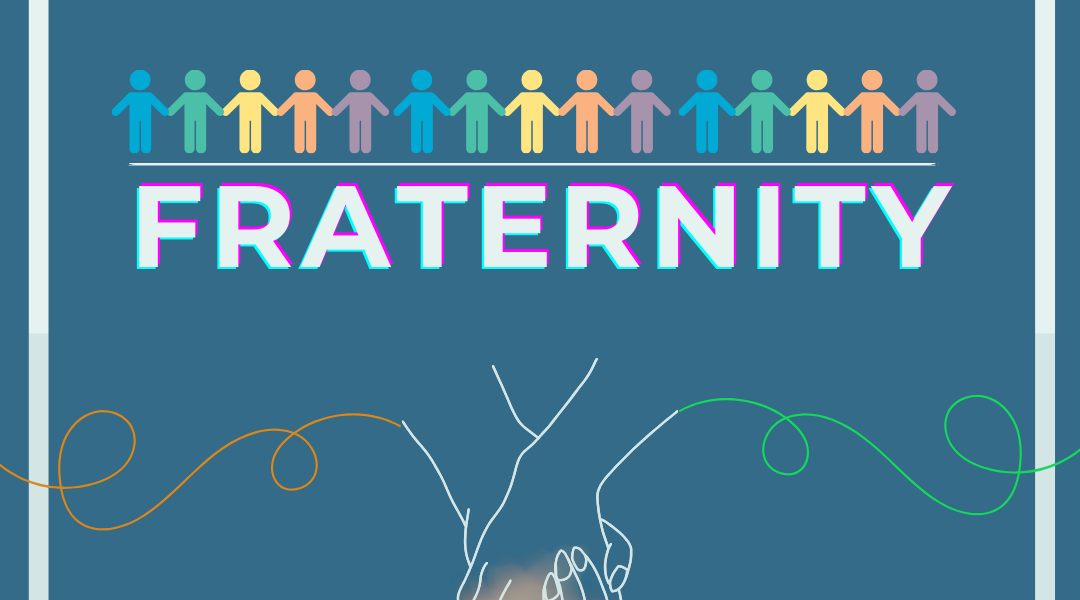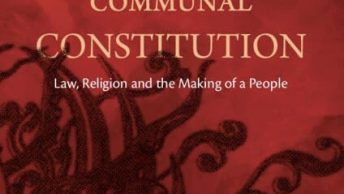Summary: In this piece, we continue the discussion on Dr. Farrah Ahmed’s Chapter on Fraternity forthcoming in the Cambridge Companion to the Constitution of India. The article can be accessed here and a summary of the article can be accessed here. In this piece, Dr. Rowena Robinson provides her comments on the article.
Introduction
Fraternity is one of the most transparent core values of modern democracy, for it takes its associations from something so familiar and indeed intimate to all of us – the domain of kinship and the idea of brotherhood. At the same time, and partly for this very reason, it is especially difficult to articulate as a legal and political concept. A first cursory read of Farrah Ahmed’s chapter on Fraternity to appear in the forthcoming The Cambridge Companion to the Constitution of India edited by Gautam Bhatia, Aparna Chandra and Niraja Gopal Jayal covers well-worn terrain with regard to its earlier treatment in the literature, the reading of Indian constitutional debates, its insertion into judgments and even its critiques on grounds of gender. However, a more careful reading reveals the distinctiveness of Professor Ahmed’s arguments, and her attempts to critically think through constitutional and jurisprudential assumptions regarding fraternity. I will first highlight the aspects of the chapter I found most interesting before outlining some questions that it gave rise to, and areas where it could go further in advancing our understanding of this key concept.
Ahmed’s Analysis of Fraternity
Ahmed begins by stating that fraternity deserves attention as a constitutional value and has strong links with other values, such as dignity, equality, and liberty. She sets out to show that it should be understood as an ideal of the affective bonds of brotherhood and it functions as a way to transcend differences between citizens by calling on them to manifest virtues such as generosity and tolerance. However, in a significant move, Ahmed develops through the chapter a candid critique of these very ideas particularly in the ways in which they emerge from Indian constitutional and jurisprudential readings. She points out how the ideas of brotherhood and fraternal equality are simultaneously undercut by patronizing references to the ‘younger brother’ while referring to disadvantaged castes or marginalized communities both in constitutional assembly debates and Supreme Court judgments. She is appreciative of the anti-caste underpinnings of the preambular text with its reference to dignity but sees the latter as an ‘obscure’ value. This is partly linked to her caution regarding fraternity being understood as a duty to show respect or reverence to fellow citizens. According to her, the articulation of fraternity as a duty comes with the inherent danger of its being invoked to curtail individual freedoms.
With regard to fraternity being called upon to overcome differences between citizens and across groups, Ahmed notes that firstly, fraternity does not demand the erasure of differences but rather their tolerant acceptance—particularly those of a religious, political, or linguistic nature. On the other hand, the differences not accepted or folded into the meaning of fraternity are caste differences, because they are prejudicial and predicated on indignities associated with the presumed lack of status. It is in relation to the ‘virtues’ of tolerance and generosity that Ahmed argues fraternity is often associated with, that her critical appraisal becomes sharper and manifests wider implications, including for the notion of nationalism and constitutionalism itself.
For instance, tolerance aligns with the Hindu view of itself as a non-proselytizing faith and thus, becomes the basis for condemning proselytizing religions such as Islam or Christianity, which are viewed as intolerant and threatening of the equilibrium and concord needed between religious communities. A far more troubling association according to the author, is that of fraternity with generosity. When taken to mean the generosity of the privileged, the powerful or the majority, it can become the foundation for arguing that constitutional democracy essentially constrains and requires sacrifices of the Hindu community while preserving the cultural and religious practices of the minorities. While Hindus are subject to a wide variety of reform measures, courts use Narasu Appa as a dubious precedent to protect the personal laws of minorities from constitutional scrutiny. However, according to Ahmed, such forms of discourse ignore the real social, political, and material disadvantages, particularly of the Muslim minority community. Not just that, it also effectively constitutes the inclusion of all minorities within the state as a concession by Hindus thus reconstituting equal citizenship as an act of majority generosity.
Finally, the chapter critiques fraternity as a gendered concept, drawing from Carole Pateman’s idea (The Sexual Contract, Cambridge: Polity Press, 1988) that the social contract is not just limited to excluding women from the fraternal community, but also constitutes a sexual contract. It is through this contract men exercise and operationalize their sex right over women. In other words, the law becomes the basis whereby men lay down the rules between themselves regarding their orderly access to women, including the latter’s productive and reproductive capacities. According to Ahmed, the Constituent Assembly had only fifteen women and their share in the higher judiciary and as senior lawyers continues to remain low; personal laws encode patriarchal arrangements regarding the regulation of the sexual and productive labour of women; and, finally, in discourses ranging from abductions during Partition to contemporary ‘love jihad’ conspiracies, women have been perceived through a lens of anxiety regarding threats to the balance of fraternal religious communities. Ahmed appreciates that these facts do not precisely mirror Pateman’s arguments, but she cites them to make us vigilant about fraternity even as we reflect on its value. Interestingly, she quotes the clause in Article 51A which makes it the duty of all citizens ‘to promote harmony and the spirit of common brotherhood amongst all the people of India transcending religious, linguistic and regional or sectional diversities; to renounce practices derogatory to the dignity of women’. Ahmed’s reading connects the relationship between fraternity and the dignity of women cited in Article 51A, with fraternity and the dignity of those subordinated by caste contained in the preamble. She therefore sees the clause as a call for fraternal belonging that does not exclude or exploit women.
The chapter reasserts the potential of fraternity to hold the state to account if its actions: (1) threaten fraternal relations between groups; (2) link state benefits or citizenship to group membership; and (3) enable its own capture by any particular group. She also asserts that if constitutional discourse impacts public culture and the latter is seen to be influential in shaping people’s “ideal affect”, then giving fraternity greater prominence in this discourse might promote it as an ideal to be socially valued and inculcated among citizens.
Unaddressed Issues
It seems to me, though, that some of the maladies that Ahmed appears to lay at the door of fraternity in the course of the chapter – such as feeding majoritarian resentment – may equally be the burden of other significant constitutional values, such as secularism for instance. Further, given Ahmed’s overall misgivings about prevailing narratives of fraternity, her concluding hope that constitutional discourses might shape public affect and make people more fraternal seems unconvincing and rife with precisely the kind of assumptions she has been cautioning the reader against throughout the chapter. Ahmed is perhaps not critical enough of the notion of dignity, particularly in the way it tends to be associated with women in Indian legal and political discourses. She may also be somewhat dismissive of it, given its resurfacing in contemporary political philosophy discourses as a weighty and worthy concept.
Finally, we are living in a very different time compared to a decade or so earlier, when the discussion on fraternity in the Indian context was first initiated. Since then, worldwide, the thinking on fraternity and the related concept of solidarity has become more intense and the pandemic pushed these debates even further in the direction of the possibilities of transnational ties and connections. Though Ahmed cites some of these in passing and she is no doubt bound by the requirements of the book, both in terms of scope and length, perhaps she misses a chance to place her arguments more thoroughly in relation to these deliberations in scholarship in general, as well as in a comparative constitutional framework. In the end, though, her careful and critical endorsement of fraternity is appreciated, as well as the fact that she unearths its easy co-option in political projects, particularly those with manifestly majoritarian and hierarchal implications. In this lies the perceptiveness of her account.
Rowena Robinson is Professor of Sociology at the Department of Humanities and Social Sciences, IIT Bombay and has taught earlier at Delhi and Jawaharlal Nehru Universities. Her current areas of research include minority studies, structural inequality and ethnic conflict, constitutional law, civil society and public policy. Among other publications, she is the author of Boundaries of Religion (OUP, 2013) and Christians of India (Sage, 2003), and editor of Minority Studies (OUP, 2012). She is co-editor of Margins of Faith: Dalit and tribal Christianity in India (Sage, 2010) and of Religious conversion in India: modes, motivations and meanings (OUP, 2003) and has also published widely in academic journals.
Ed Note: This Discussion was coordinated and edited by Vishnu Bandarupalli with assistance from Saranya Ravindran and published by Baibhav Mishra from the technical team of the Student Editorial Team






jq0km9
2pnyl7